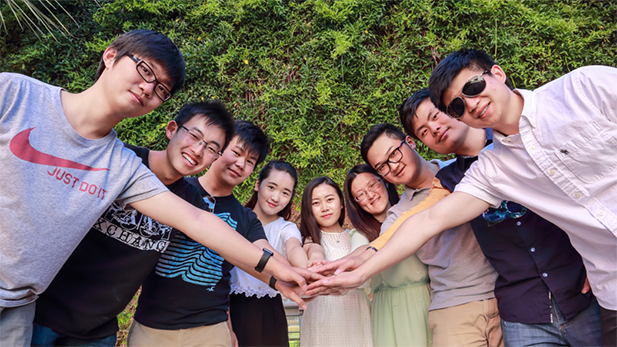
The University of Arizona enrolled nearly 4,000 foreign students in fall 2016 – almost 10 percent of the university’s total enrollment. In the last decade, the number students from China, which once accounted for a fraction of international enrollment, has skyrocketed.
Chinese students now account for 48 percent of all international scholars. That has prompted quite a few changes in how these students are assimilated into and educated at the university.
'The Word is Out'
When Noelle Sallaz joined International Student Services as an associate director in 2006, less than 40 Chinese undergraduate students were enrolled at the UA. This year, according to ISS records, 1,392 undergrads hail from the East Asian nation, making them the largest group of international students by far.
“The word is out,” Sallaz said. “Students have found the UA a good place to obtain their degree.
“In the last 10 years or so, we’ve really seen the effects of the growing economy in China, and also the desire to study here in the U.S.,” she added. “The U.S. is seen as the premier destination to obtain your degree abroad.”
Megan Ma, a graduate student majoring in marketing, grew up in Shanghai, the most populous city in China. She came to Tucson four years ago, and is one of more than 1,906 undergraduate and graduate students from the People’s Republic of China.
“I like how quiet [it is here], rather than, like, big important cities,” Ma said. “Less attraction, but more concentration.”
According to the ISS – a UA-sponsored service that helps foreign-born students with immigration issues, academic advising and cultural adaptation – the next biggest foreign-student group comes from India, which fronts a comparatively modest 350 students.
Zhijia Yang is a junior majoring in psychology. He goes by Jason, or simply Yang because Americans have difficulty pronouncing his Chinese first name. The sheer number of people competing for spots at Chinese universities makes it difficult for many people to attain such a coveted higher education, he said.
“There is a lot of competition in China, and the successful people would be few,” he noted. “In America, people want it – and do it. It is pretty awesome.”
Though Yang was invited to study at a Chinese university, he said he was drawn west by the lure of the American Dream: With dedication and sacrifice, people of all socioeconomic classes have an equal opportunity for success and prosperity.
When he came to the U.S. he realized, “any dream may become true. But I have to work hard.”
A Difficult Transition
International students face many difficulties studying abroad, Sallaz said. Overcoming cultural differences like questioning instructors and thinking critically can be difficult.
“They’re just not used to the idea of being able to challenge authority,” she said. “That’s a big adjustment for our students: being able to freely express their opinions and ideas and not get in trouble for that.”
Foreign students also must make academic skills adjustments, especially in language. That includes use of the written word.
Erin Whittig is transfer and placement coordinator for the UA Writing Program. She also teaches a writing composition course aimed at bolstering international students’ writing skills.
“There are certain tests that they take that show that they are, quote, ‘ready for college.’ But that readiness is quite questionable,” she said. “They do need some additional work.”
But overall, she emphasized, Chinese students are dedicated scholars.
“They come from a different linguistic tradition that’s going to value different discourses, and that doesn’t make those discourses wrong,” she said. “It makes them different. It’s our responsibility to meet them halfway.”
Meeting Them Halfway
This semester, the UA launched a new course that provides an extra semester of writing instruction for foreign students. It is called “English Composition for Speakers of English as an Additional Language,” and Whittig is one of the instructors.
Initially, she wasn’t sure her Chinese students understood her because they sat quietly and didn’t show attention “cues” like head nodding or questions. She learned that those behaviors are not encouraged in Chinese schools.
“That’s seen as rude,” she explained. “It’s considered an interruption. The [signs of attention] are not there – the American ones that I’m conditioned to look for – so I have to recalibrate and look for other clues.”
“They come from a different linguistic tradition that’s going to value different discourses, and that doesn’t make those discourses wrong. It makes them different. It’s our responsibility to meet them halfway" - Erin Whittig, UA Writing Program transfer and placement coordinator.
Language barriers can cause a variety of misunderstandings, said Megan Ma, whose Chinese name is Shuqiao.
“Sometimes we just don’t find a way to explain ourselves in English,” she said. “But every one of us is eager to make friends on this campus, to be part of any programs or events or any department activities. So that’s why we need encouragement or inspiration from the professors, faculties or even just peers.”
International Student Services is sponsoring a seven-week conversational series called “Let’s Talk About … ” It is aimed at helping foreign-born students become more familiar with American culture, university life and speaking English.
It’s also important for Chinese students to form a sense of community so far from home, said Yang, who is president of the campus Association of Chinese Students and Scholars.
That’s because many students will return to China after their studies and internships end.
“I like America, and I am enjoying the experience,” he said. “(But) in the end, I have to go back to China, because there is my family. There are my old friends.”
Visit the websites of University of Arizona International Student Services and the UA chapter of the Association of Chinese Students and Scholars.

By submitting your comments, you hereby give AZPM the right to post your comments and potentially use them in any other form of media operated by this institution.